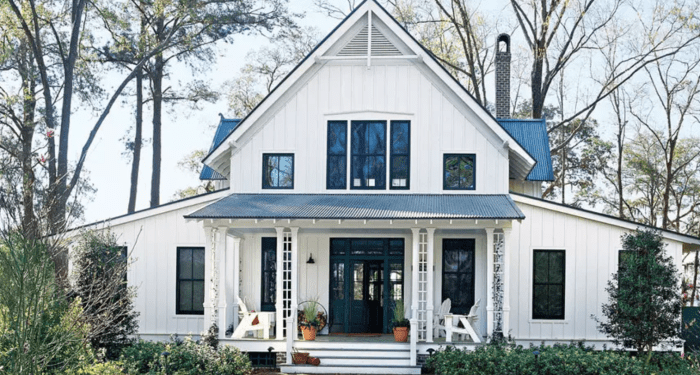Embarking on a journey through the world of board and batten home exteriors unveils a fascinating blend of history, design, and practicality. From its humble origins to its modern-day applications, this style of siding offers a unique charm that can transform any home.
As we delve deeper into the details, you'll discover the key elements that make board and batten exteriors stand out, along with the benefits they bring to residential architecture.
. By combining clean lines and minimalistic design elements, board and batten siding can add texture and visual interest to a modern home.
Overview of Board and Batten Home Exterior
Board and batten siding is a type of exterior finish where wide vertical boards are joined together by narrow strips known as battens. This method creates a rustic and charming look for homes.History and Origins of Board and Batten Exteriors
The concept of board and batten siding dates back to medieval Europe, where it was used as a practical and inexpensive way to protect homes from the elements. The design became popular in North America during the 19th century, especially in rural areas where it was easy to source materials.Characteristics of a Board and Batten Home Exterior
- Vertical orientation: Board and batten siding features vertical boards that are typically wider than the battens, giving the exterior a distinctive look.
- Rustic appeal: The overlapping boards and battens create a textured and visually appealing finish that adds character to the home.
- Weather resistance: The design of board and batten siding helps to shed water and protect the underlying structure from moisture damage.
- Versatility: Board and batten exteriors can be customized with different types of wood, finishes, and colors to suit various architectural styles.
Benefits of Board and Batten Siding
Board and batten siding offers several advantages for home exteriors, making it a popular choice among homeowners looking for a unique and durable option.Advantages of Board and Batten Siding:
- Enhanced Durability:Board and batten siding is known for its exceptional durability, providing long-lasting protection against the elements. The thick boards and battens offer strength and resilience, making it a sturdy option for homes.
- Timeless Aesthetic:The classic look of board and batten siding adds a charming and timeless appeal to any home. It can complement various architectural styles, from traditional to modern, enhancing the overall curb appeal.
- Versatility:Board and batten siding can be customized in terms of color, size, and layout to suit individual preferences and design requirements. This versatility allows for a personalized touch that can elevate the visual impact of a home.
- Low Maintenance:Compared to other types of siding, board and batten requires minimal maintenance. Routine cleaning and occasional repainting are usually sufficient to keep it looking fresh and vibrant over the years.
Design Elements and Variations
When it comes to board and batten exteriors, there are various design elements and variations that can be explored to create a unique look for your home.Color Choices Impact
The color choices for your board and batten siding can have a significant impact on the overall aesthetic of your home. Dark colors tend to make a home look more traditional and classic, while lighter colors can give a more modern and fresh appearance.Incorporating into Modern Architecture
Board and batten siding can be seamlessly incorporated into modern architecture to create a sleek and contemporary lookInstallation and Maintenance
Installing board and batten siding is a straightforward process that requires attention to detail and precision to ensure a durable and visually appealing exterior. Proper maintenance practices are essential to prolong the lifespan of the siding and keep it looking its best. Let's delve into the specifics of installation and maintenance for board and batten exteriors.Installation Process
- Begin by preparing the surface where the siding will be installed, ensuring it is clean, smooth, and properly sealed.
- Measure and cut the boards to the desired length, making sure to leave space for expansion and contraction.
- Install the boards vertically, starting from one corner and working your way across in a staggered pattern.
- Secure the boards to the wall using nails or screws, making sure they are level and properly spaced.
- Once all the boards are in place, install the battens over the gaps between the boards to create a seamless look.
- Finish by painting or staining the siding to protect it from the elements and enhance its aesthetic appeal.
Maintenance Practices
- Regularly inspect the siding for any signs of damage, such as cracks, rot, or insect infestations.
- Clean the siding periodically by washing it with a mild detergent and water to remove dirt, mold, and mildew.
- Repaint or restain the siding as needed to maintain its protective coating and keep it looking fresh and vibrant.
- Trim back any vegetation that may be growing near the siding to prevent moisture buildup and potential damage.
Special Considerations
- Ensure proper ventilation behind the siding to prevent moisture buildup and potential rot.
- Consider the climate and weather conditions in your area when choosing materials and finishes for the siding.
- Be mindful of any special requirements or regulations in your local area regarding the installation and maintenance of board and batten siding.
- Consult with a professional if you encounter any issues or are unsure about how to properly install or maintain the siding.















